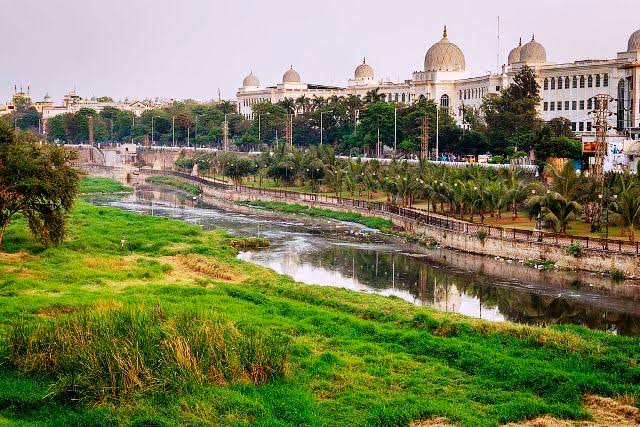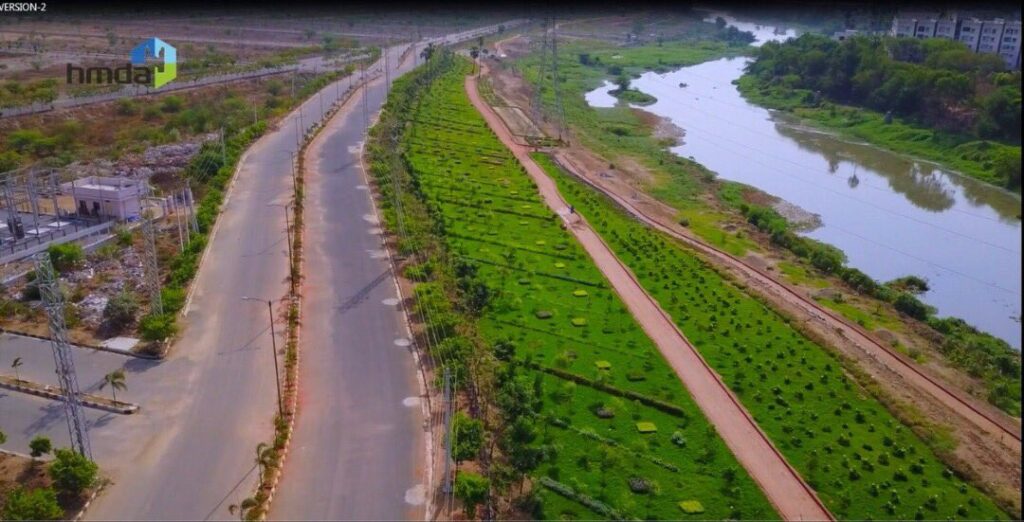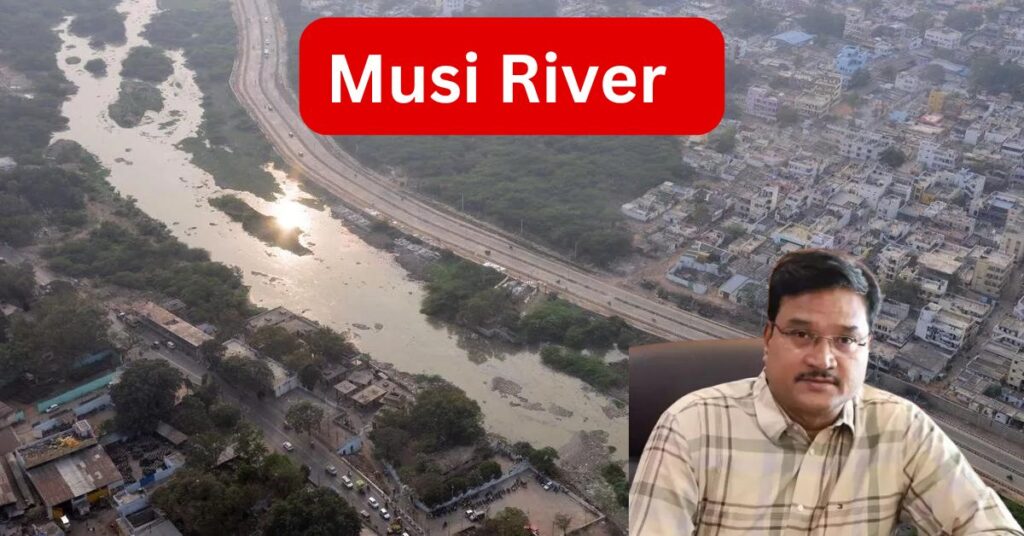Introduction:
Beyond the immediate issues of community resistance, legal hurdles, and political pressures, HYDRA faces other significant challenges as part of its ongoing efforts to clear encroachments along the Musi River. These challenges involve environmental considerations, long-term sustainability, resource allocation, and coordination with multiple agencies. Let’s explore these in more detail.
1. Environmental and Ecological Impact:
Ecosystem Restoration: One of the primary goals of the Musi Riverfront Development Project is to restore the natural ecosystem of the river. However, decades of encroachment have led to extensive pollution and environmental degradation. Clearing encroachments and restoring the river’s ecological balance will require significant investment in cleaning up the river, controlling pollution sources, and revitalizing its biodiversity.
Waste Management: A major challenge in clearing encroachments is dealing with the waste left behind. Many encroachments consist of semi-permanent structures, the removal of which will generate large amounts of construction debris and waste. Proper waste disposal mechanisms will need to be in place to ensure the river’s recovery is not further hampered by additional environmental damage.

2. Inter-Agency Coordination:
Multiple Stakeholders Involved: The Musi River revitalization project involves coordination between several governmental agencies, including HYDRA, the Hyderabad Metropolitan Development Authority (HMDA), the Greater Hyderabad Municipal Corporation (GHMC), and environmental departments. Coordinating actions between these agencies to ensure smooth operations can be complicated, with delays often resulting from bureaucratic red tape.
Overlapping Jurisdictions: The Musi River cuts across multiple administrative zones, creating overlapping jurisdictions. Disputes over responsibility between local authorities and central agencies can lead to delays and conflicting directives. This issue adds complexity to the already challenging task of enforcing encroachment clearances.
3. Infrastructure Challenges:
Flood Control Measures: In recent years, the Musi River has become a flood-prone area due to the accumulation of debris, silt, and unplanned construction along its banks. Before demolitions can proceed, HYDRA needs to implement flood mitigation measures such as dredging, constructing embankments, and installing proper drainage systems to protect both the river and surrounding areas. Failure to do so could result in worsened flood risks, particularly during heavy rains.
Relocation of Utilities: Many encroachments have developed alongside or even over essential utilities, such as water pipelines, electrical grids, and drainage systems. Clearing these encroachments will require the relocation or upgrading of infrastructure, which may increase project costs and extend the timeline.
4. Financial and Resource Allocation Issues:
Funding Constraints: Although the project has an allocation of ₹1500 crore, managing this budget efficiently is critical to ensure that all aspects of the project—from demolitions to rehabilitation and environmental restoration—are properly funded. Overruns in one area (such as compensation) may limit available resources for other aspects, such as waste management or flood prevention.
Manpower Shortages: Large-scale demolition efforts require substantial manpower, including surveyors, demolition crews, engineers, and security personnel. HYDRA must ensure it has the necessary workforce and equipment to execute demolitions while also maintaining public order and safety.

5. Long-Term Sustainability:
Preventing Future Encroachments: While HYDRA is focused on clearing existing encroachments, the agency must also develop long-term strategies to prevent new illegal settlements from cropping up along the riverbanks in the future. This will involve stricter enforcement of zoning laws, increased monitoring of vulnerable areas, and enhanced public awareness campaigns to discourage illegal construction.
Sustainable Urban Planning: The Musi Riverfront Development Project aims to create a vibrant, sustainable urban space. However, ensuring that the infrastructure built along the river is eco-friendly and sustainable is crucial. Overdevelopment or improper planning could jeopardize the environmental gains made through the clearance of encroachments.
Also Read: HYDRA Demolition in Kukatpally and Ameenpur Illegal Constructions
6. Public Relations and Communication Challenges:

Building Public Trust: HYDRA’s efforts to clear encroachments are often seen as adversarial by affected communities. The agency must improve its public relations efforts, communicating clearly the long-term benefits of the riverfront project to the city’s residents. Building trust through transparent dialogue, community consultations, and fair compensation policies is essential for the project’s success.
Engagement with Local Leaders: In addition to public communication, HYDRA needs to actively engage with local leaders, NGOs, and activists who are advocating for the rights of displaced residents. By involving these stakeholders in the decision-making process, HYDRA can create a more inclusive approach to urban development and avoid the risk of alienating large sections of the population.
HYDRA’s progress in demolishing encroachments along the Musi River:
| Location | Total Encroachments | Encroachments on Riverbed | Encroachments in Buffer Zones | Structures Cleared So Far |
|---|---|---|---|---|
| Nampally & Bahadurpura | 6,000+ (over 50%) | Significant portion | Not specified | In progress |
| Other Areas | Approx. 6,000 | Remaining portion | Not specified | In progress |
| Total | 12,000+ | 2,166 | 10,200 | 1,600 (riverbed) |
Breakdown:
- Riverbed Demolition: HYDRA has initiated the demolition of 1,600 structures occupying the riverbed.
- Target: The overall goal is to remove approximately 12,000 encroachments from the riverbanks and buffer zones.
- Focus Areas: The demolition effort is currently concentrated on structures on the riverbed, with buffer zone structures to follow.
Also Read: Encroachment and unauthorized construction demolished By HYDRA in FTL & Buffer Zone
7. Technological and Logistical Solutions:
Use of Modern Technology: To streamline operations, HYDRA can employ modern technology such as GIS mapping and drones for accurate surveying of encroached areas. This would help identify illegal structures quickly and ensure precise documentation of land use, making the demolition process more efficient.
Automated Monitoring Systems: To prevent future encroachments, automated monitoring systems such as surveillance drones or satellite imagery can be deployed. These systems would allow HYDRA to detect new illegal constructions in real-time, facilitating quicker interventions.
HYDRAA’s phased demolition approach and key elements:
| Aspect | Details |
|---|---|
| Phased Demolition | Initial focus on structures built directly on the Musi riverbed, followed by Full Tank Level (FTL) and buffer zone encroachments. |
| Coordination with Authorities | Collaboration with HMDA and MRDCL to share findings and streamline demolition efforts. |
| Community Rehabilitation | Double-bedroom houses provided to displaced residents as part of a rehabilitation package. |
| Legal Framework | Issuance of formal notices to affected residents, allowing legal responses and minimizing backlash. |
| Monitoring & Enforcement | Continuous inspections and surveillance to identify new encroachments and ensure compliance with demolition orders. |
| Funding & Resources | ₹2,500 crore budget allocation for demolition efforts and construction of new housing for displaced individuals. |
Conclusion:
The challenges faced by HYDRA in clearing encroachments along the Musi River are multifaceted, ranging from strong community resistance to complex legal, environmental, and operational hurdles. Successfully overcoming these obstacles requires not only strategic planning and inter-agency coordination but also transparent communication with affected communities and a focus on long-term sustainability. By adopting a holistic approach that balances urban development with environmental restoration and social equity, HYDRA can achieve its vision of transforming the Musi River into a sustainable and vibrant urban space.
Frequently Asked Questions:
HYDRA’s main challenges include community resistance, legal hurdles, environmental degradation, inter-agency coordination, and managing the long-term sustainability of the river ecosystem.
HYDRA will focus on ecosystem restoration by cleaning up pollution, managing waste from demolished structures, and implementing flood control measures to protect the river and surrounding areas.
HYDRA is coordinating with agencies like the Hyderabad Metropolitan Development Authority (HMDA), Greater Hyderabad Municipal Corporation (GHMC), and environmental departments to streamline demolition efforts and manage overlapping jurisdictions.
The government has earmarked ₹1,500 crore for demolition, rehabilitation, and environmental restoration efforts, but resource allocation remains a key challenge for HYDRA.
HYDRA plans to implement stricter zoning law enforcement, increased monitoring through modern technologies like GIS mapping and surveillance, and public awareness campaigns to prevent illegal settlements from reoccurring.
Suggested Articles:
HYDRA Demolition in Kukatpally and Ameenpur Illegal Constructions
Encroachment and unauthorized construction demolished By HYDRA in FTL & Buffer Zone







































